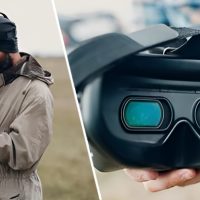Emerging from the battlefield’s innovation, drones have gone beyond military origins to become a common sight today. Both experts and enthusiasts can easily pilot them. Drones are a collection of advanced technology pieces working together seamlessly to make this possible. One piece of technology is crucial for getting those clear photos and videos from hundreds of feet above – a drone gimbal. What is a gimbal on a drone, how does it work, and its vital role in aerial photography and filming? Let’s find out.
What is a gimbal on a drone?

A gimbal is a smart support system that keeps the drone camera steady no matter how much it moves around.
For example, when people make videos while walking or running, gimbals ensure the camera doesn’t shake. Similarly, on a drone, gimbals stop the camera from wobbling, even when the drone is flying around.
Gimbals do this by using special motors and sensors. These parts automatically fix any wobbling or tilting, making your photos and videos smooth and steady.
What are the different types of gimbals available for drones?

There are two main types of gimbals available for drones.
- 2-axis gimbals
- 3-axis gimbals
2-axis gimbals stabilize the camera on the pitch and roll axes. This is the most basic gimbal type and is typically less expensive than 3-axis gimbals.
3-axis gimbals stabilize the camera on the pitch, roll, and yaw axes. It provides the highest level of stabilization and is ideal for capturing smooth video footage, even in challenging conditions.
How does Gimbal work for a drone?
A gimbal keeps a camera or object steady, no matter how the platform it moves. They’re used in various applications, including drones, smartphones, and cameras.
In drones, a gimbal stabilizes the camera for smooth video, even during turbulence or sudden movements. It does this using motors and sensors.
The Gimbal is mounted under the drone, and the camera attaches to it. The Gimbal has three axes: pitch, roll, and yaw, each controlled by a separate motor.
When the drone moves, the sensors detect it and tell the motors to adjust the camera’s position to keep it level. For instance, if the drone tilts forward, the Gimbal tilts the camera backward to maintain a level view.
Gimbals work with various drones, but the type you need depends on your drone and the footage you want to capture. They use sensors like accelerometers and gyroscopes, send data to motors, move the camera opposite to drone movements, work in three axes, and result in stable footage even during drone flights.
Gimbal Benefits for Drone
Gimbals offer several significant benefits for drones, making them a crucial accessory for capturing high-quality aerial footage.
- Stability
The primary benefit of a gimbal is stability. It keeps the camera or other payload steady, minimizing vibrations and unwanted movements caused by drone flight or external factors like wind. This stability ensures that your photos and videos are clear and smooth.
- Professional-Quality Footage
You can achieve professional-grade footage and photos that rival ground-based cameras with a gimbal. The stabilized camera allows for precise framing and avoids the shaky or jittery effect commonly seen in non-stabilized drone footage.
- Versatility
Gimbals are versatile and can accommodate various cameras and payloads, from action cameras to DSLRs and thermal imaging cameras. This adaptability makes them suitable for various applications, from filmmaking and photography to surveying and search-and-rescue missions.
- Improved Control
Gimbals often come with user-friendly features like remote control or smartphone apps that allow operators to adjust camera angles and settings in real time. This enhanced control enables creative framing and precise shots.
- Reduced Post-Processing
Since gimbal-stabilized footage is inherently smooth and steady, it reduces the need for extensive post-processing to correct shaky video or remove vibrations. It saves time and effort during the editing process.
- Improved Safety
Stabilized cameras are less prone to sudden jerks or movements, reducing the risk of damaging the drone or the camera equipment during flight. This increased safety is especially valuable when flying in challenging conditions or over rugged terrain.
- Professional Appeal
Whether you’re a professional filmmaker or an amateur enthusiast, using a gimbal on your drone adds professionalism to your work. The smooth, cinematic quality of footage captured with a gimbal can set your content apart.
Are gimbals compatible with all drones?

Gimbal compatibility with drones relies on factors like payload capacity, mounting mechanism alignment, power supply, communication protocol matching, firmware and software integration, and mechanical clearance.
Drone users need to assess these technical aspects to ensure compatibility. Verify that your drone can handle the added weight, and confirm the Gimbal’s mounting system aligns with your drone’s setup.
Check if your drone can provide the power for the Gimbal and ensure the communication protocol matches. Compatibility often needs firmware updates or software integration. Additionally, check for mechanical interference and assess control methods to ensure smooth operation.
Jose E. Johnson is a true tech prodigy whose lifelong passion for technology and gadgets has blossomed into remarkable drone expertise. From the moment he laid eyes on his first electronic toy as a child, Jose was captivated by the limitless possibilities of innovation. As he grew, so did his fascination with cutting-edge tech, leading him to become a bona fide drone expert. With an insatiable thirst for knowledge, Jose delved deep into the intricacies of drone technology, amassing a wealth of technical knowledge and hands-on experience. Now, he shares his wisdom through insightful drone reviews and invaluable tips for fellow enthusiasts, making him a trusted source in the drone community.







Leave a Reply